What are Decentralized Physical Infrastructure Networks (DePIN)?
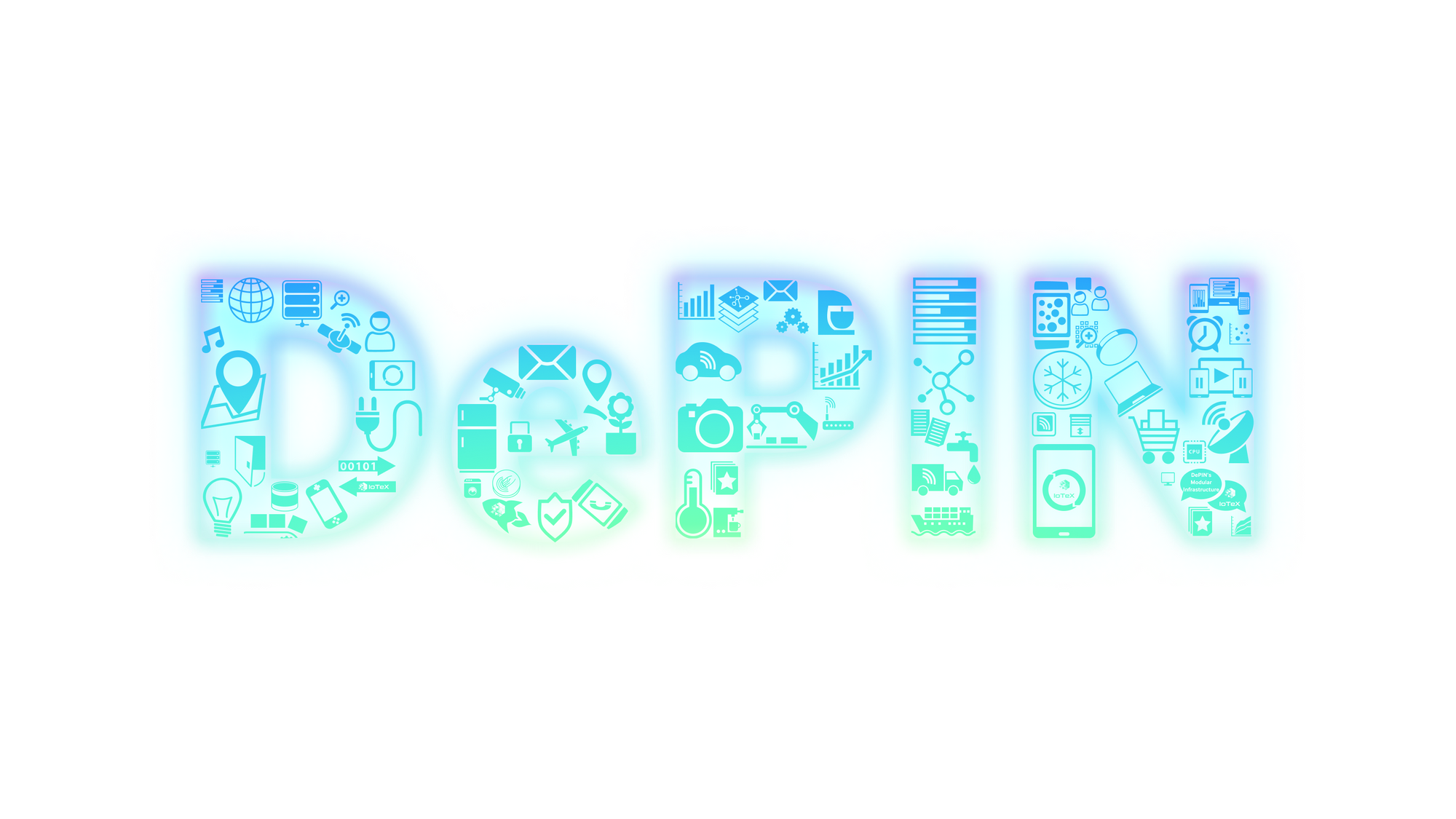
What does DePIN stand for?
DePIN stands for Decentralized Physical Infrastructure Networks. It's a new way to build and maintain infrastructure in the physical world. This "infrastructure" can be anything from WiFi hotspots in wireless networks to solar-powered home batteries in energy networks. DePINs are built out in a decentralized way, by individuals and companies all over the world, for anyone to use. In return, these contributors receive financial compensation and an ownership stake in the network they're building and the services they're providing (via token incentives). DePINs are made possible through widespread Internet connectivity and technological advancements in blockchain infrastructure and cryptography.
Here at IoTeX, we're big believers that the infrastructure of the future should be open, permissionless, and built by as many network participants as possible. We've been working at the intersection of physical devices (and their data) and blockchain technologies since 2017 (long before "DePIN" was even a thing). The way the world's infrastructure is built and deployed has remained stagnant for far too long and we can't wait to help change that for the better.
With DePINscan, builders have access to an out-of-the-box map explorer and dashboard. Providing invaluable data-driven insights to the greater DePIN community. Connected devices on DePINscan have grown by over 300k in the past month.
What happens when crypto and blockchain meet the physical world?
The advent of blockchain technology has had a large, innovative impact on many industries, ranging from finance (DeFi) to gaming (play to earn) to art (generative NFTs and trustless authentication). However, one area that has remained largely unchanged is physical infrastructure.
Traditionally, the deployment and management of physical infrastructure like wireless networks, cloud services, mobility networks and power grids has been dominated by large corporations due to the high capital requirements and logistical challenges associated with projects of this size. As a result, these centralized entities have had a near-monopoly on pricing and services offered to end-users, leading to a lack of competition and innovation. This results in an experience for consumers that is often subpar. Just take a look at the NPS (net promoter score, a measure of customer satisfaction) for the oligopoly that is the telecommunications industry in the United States (hint, it's incredibly low).
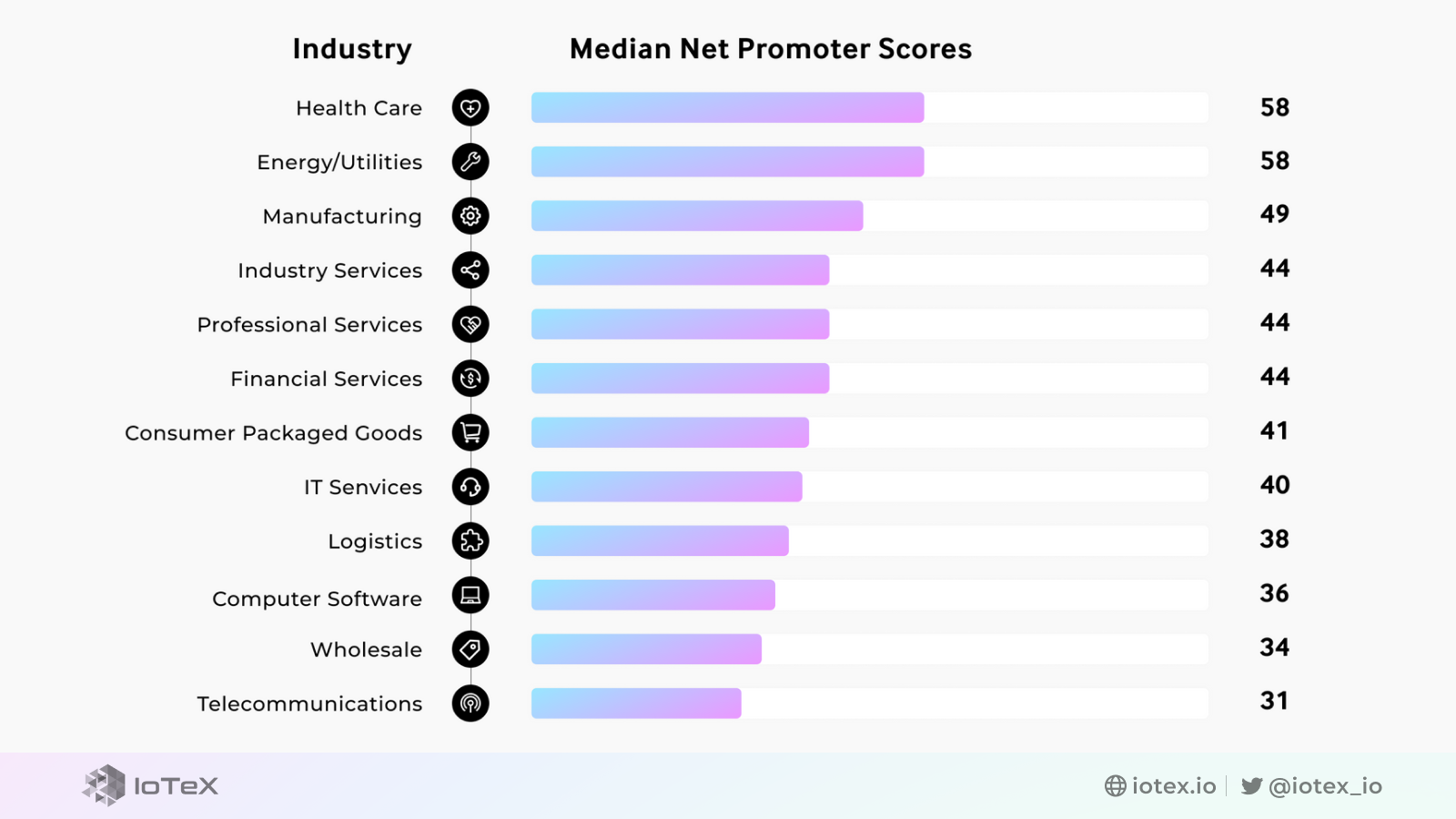
However, even as we surface the undesirable results of infrastructure built by a few, centralized corporations, there is hope! Companies that leverage the assets, time, and energy of network members to provide their services are operating in the exciting middle ground between fully centralized infrastructure and DePIN. This concept is called the "Sharing Economy".
DePIN as the evolution of the Sharing Economy
Companies like Uber and Airbnb have unlocked massive amounts of value utilizing this "Sharing Economy" model. The "Sharing Economy" describes how Uber, Airbnb, and others leverage contributors (and their assets) to provide valuable goods and services. The diagram below shows how the "Sharing Economy" typically works.
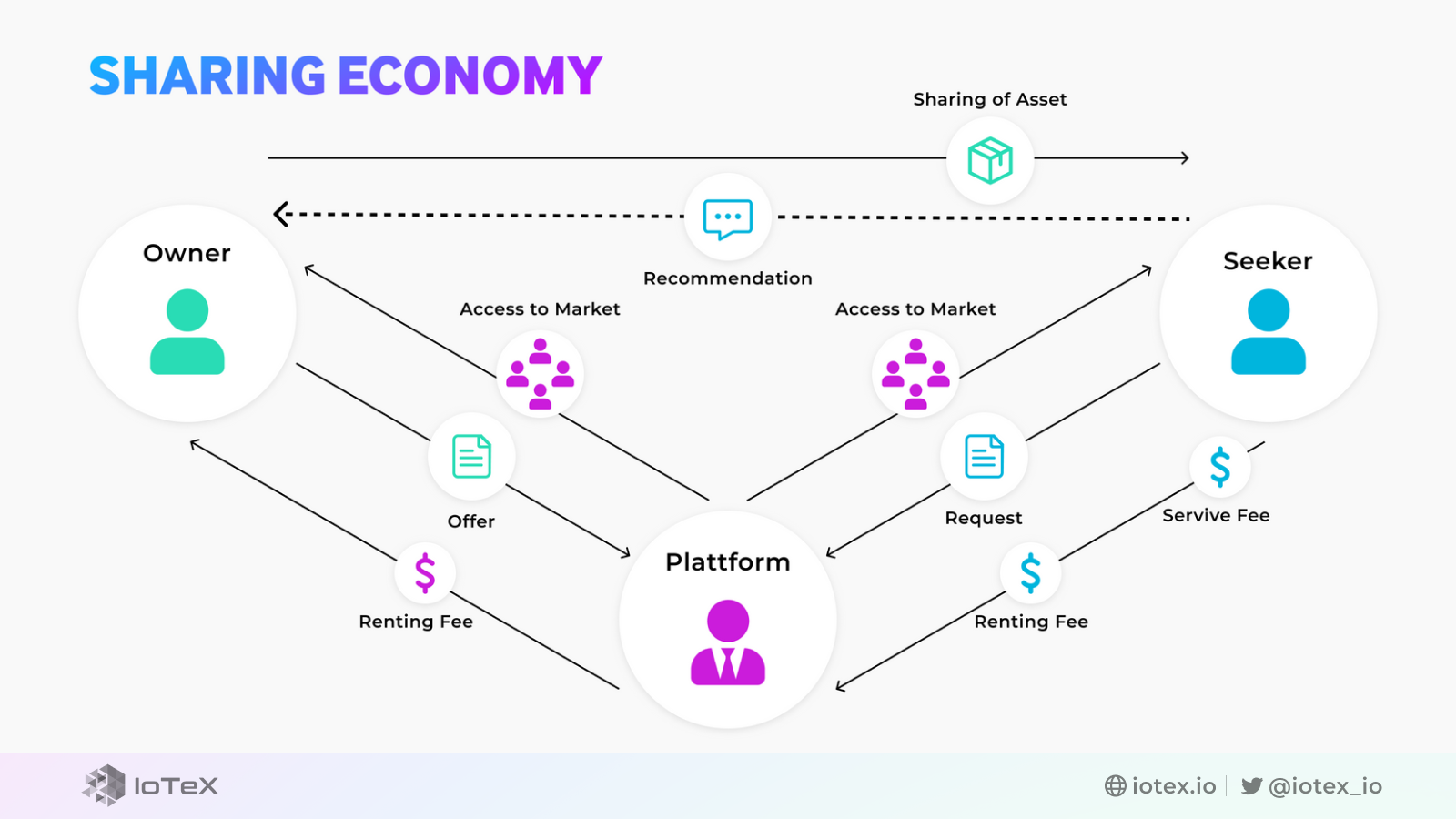
However, because Uber is a centralized entity, the power over its network, drivers, and business remain in the hands of Uber itself. The decentralized physical infrastructure movement seek to build on the idea of a "Sharing Economy" but to do so in a way that is fairer and more inclusive to the individuals and businesses actually building out the network and making this all possible.
To give an example of this in action, consider Drife. Drife is a DePIN version of Uber. Drife works similarly to Uber, matching riders with drivers who own their vehicles and are willing to drive for money. Riders pay fiat and drivers receive ~100% of that fiat payment. However, since Drife is a decentralized protocol (and not one, centralized corporation), drivers receive the $DRF token in recognition of their contributions and can both suggest and vote on changes to the protocol and its rules. In the future, Drife plans to use IoTeX's W3bstream to issue additional token incentives to drivers who are willing to drive in undercovered areas where driver supply is currently low. This will help expand the geographical footprint of Drife's driver network and benefit users greatly. This is a powerful, more inclusive version of the Sharing Economy that removes the middleman (Uber) and replaces it with a decentralized protocol, allowing for cheaper rides for riders, higher revenue for drivers, and the ability for drivers to exert influence on the network they're helping build every day.
We've seen how DePIN takes the "Sharing Economy" one step further with token incentives and distributed governance. But DePINs bring many other exciting innovations to the infrastructure of the future too!
Why DePINs are the future
DePIN has several benefits over traditional physical infrastructure networks:
- Collective ownership: Through the use of token rewards, contributors are encouraged to deploy and maintain infrastructure. DePIN's bottom-up approach means that the network is collectively owned by its participants, rather than a small group of shareholders.
- Distributed Infrastructure Cost: A decentralized physical infrastructure network reduces overhead and expenses by leveraging the collective resources of a network's participants.
- Decentralization: A decentralized network offers a more resilient and secure infrastructure compared to traditional, centralized infrastructure networks. Building a network in a decentralized manner means that the network is less susceptible to corruption, hijacking and hacks, and other negative externalities associated with centralized control.
- Open Competition and Innovation: DePIN enables new levels of innovation across various sectors. By removing the barriers to entry associated with traditional infrastructure networks, DePIN encourages new entrants to compete in markets that were previously dominated by a few established players.
Many of the assets that we own or actions that we take every day have untapped value. If you're going to be driving your car anyways, why not have a DIMO device installed under the steering wheel to collect and monetize your car data? Or a Hivemapper mapping device on the dashboard that collects images of the road and builds a decentralized version of Google Maps? You can earn tokens and participate in both of these networks just from the comfort of your car! You could also install a smart meter, solar panel, or battery at your home to participate in Daylight Energy's DePIN project, earn tokens, and contribute energy to the grid when demand exceeds supply. All of these examples represent DePIN use cases that could be present in your everyday life. Now that you can picture how DePIN could impact your day to day routine, let's zoom out a bit and add some context about where DePIN fits into the broader crypto landscape today.
DePIN within the context of crypto as a whole
While DePIN is a smaller, emerging sector of crypto today, its potential for growth is massive as this model is used to build better networks across industries as diverse and as large as telecom, energy, mobility, and storage.
While the real world economy is easily valued in the hundreds of trillions of dollars, Messari recently wrote that the DePIN sector's total addressable market is currently ~$2.2T and could reach ~$3.5T by 2028. This is ~3x the market cap of all of crypto today. The FDV (fully diluted value) of all decentralized physical infrastructure projects is currently only ~$5B. DePIN projects are looking to solve some of the world's most fundamental problems by leveraging blockchain technology, token incentives, and the power of the Internet.
Here's a sector map that includes most of the DePIN projects on the market today. We've categorized them into four broad groups: server projects, infrastructure, sensor projects, and wireless projects. IoTeX (and our W3bstream product) are a core part of the infrastructure powering these DePIN projects, as we help connect smart devices and their data to smart contracts on blockchains. W3bstream is middleware. It's a general purpose, off-chain compute environment that's focused on reducing go-to-market time for DePIN and RWA projects and acting as an "oracle for the real world".
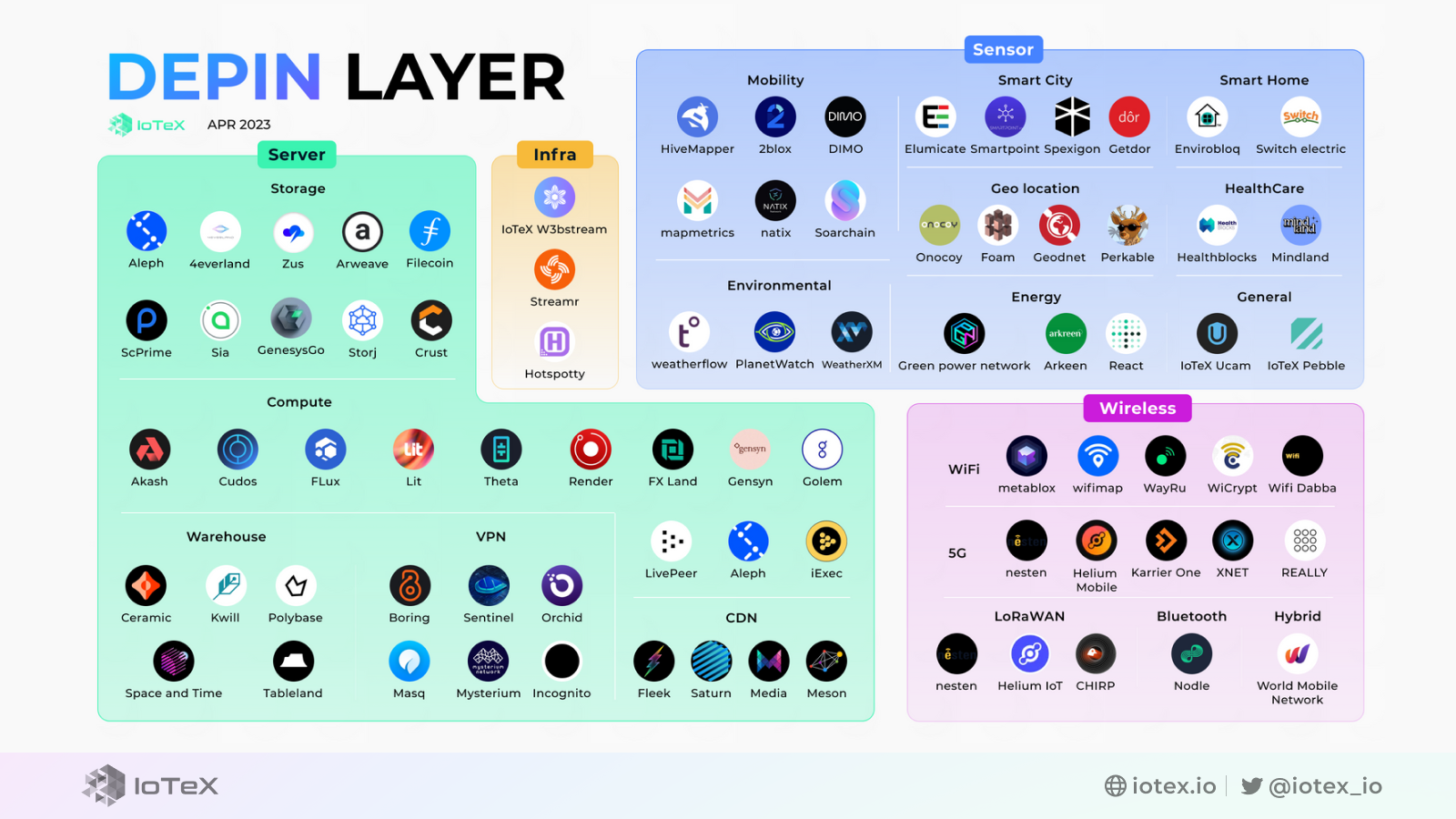
DePINscan is a new data aggregation and visualization tool that shines the light of transparent data on the entire DePIN sector. DePINscan’s Map and Discover features create a full picture of the projects that make up this sector and its connected devices.
Read on to hear about the history of the "DePIN" term and the other acronyms that were used before it to describe this space.
The DePIN origin story

The term "DePIN" is the acronym the industry has settled on to describe this up and coming sector of crypto. We have Messari to thank for suggesting this acronym and uniting the space under one banner, but there have been a few other terms used to describe this sector in the past that are worth exploring.
In November of 2021, IoTeX became the first to place a label on this up-and-coming sector, calling it MachineFi (a play on words combining "machine" with "DeFi" to represent the financialization of machines and their data).
In April of 2022, "Proof of Physical Work" (PoPW) was introduced by Multicoin, explicitly referring to incentive structures that enable anyone to contribute permissionlessly to a set of shared objectives.
In July of 2022, "Token Incentivized Physical Networks" (TIPIN) was coined by Lattice to describe networks that use token incentives to motivate individuals to participate in the deployment and operation of decentralized networks.
In September of 2022, "EdgeFi" was proposed by Borderless Capital to include decentralized infrastructure networks that focus on deploying hardware resources closer to end-users at the network's edge.
In November of 2022, Messari conducted a Twitter poll to unite the space under one acronym, with voters choosing between PoPW, TIPIN, EdgeFi, and DePIN. DePIN won with 31.6% of the votes.
On December 22, 2022, in its annual "Theses", Messari mentioned "DePIN" in research for the first time, stating that it "will be one of the most important areas of crypto investment for the next decade."
On January 19, 2023, Messari published a report devoted entirely to DePIN and the rest is history.
While there will undoubtedly be new acronyms suggested as this space grows and matures, we stand behind "DePIN" given that the defining characteristic of these networks (and their primary differentiator) is their decentralization.
However, this decentralization brings unique challenges and creates a much different design space for the deployment and maintenance of physical infrastructure networks in the real world, today.
DePIN creates a totally new design space for physical infrastructure
Each DePIN network will involve real-world devices that are generating and sharing their data. As this dataset grows larger and larger, the design space for dapps to be built to utilize various subsets of this data or to serve niches in each market that pop up grows larger and larger as well. Take DIMO for instance. DIMO is a DePIN mobility project focused on collecting car data, analyzing it, and providing value-added services to car owners. DIMO functions as an open data platform, allowing developers to build dapps on top of the data that is collected by the network to provide valuable services to car owners themselves.
DePINs are built on four fundamental components that allow for innovation far beyond what centralized networks can provide:
- Physical infrastructure: DePINs require physical infrastructure to be built out and maintained in the physical world.
- Offchain compute infrastructure: DePIN relies on middleware that allows real-world data to be ingested, analyzed, and then used to calculate user contributions and actual demand.
- Blockchain architecture: Blockchains function as tamperproof ledgers, device registries, and the home of token economies.
- Token incentives: Tokens are used both as an incentive to build out the supply-side of a network (e.g. motivate contributors) and also often as the currency that demand for the network's services is priced in (e.g. purchasing broadband access).
These components are powerful new tools in the toolkits of DePIN builders, but this power comes at a cost. Building any kind of physical infrastructure in the real world is difficult. Correctly setting up and then implementing functional, decentralized middleware that records real-world activity on a blockchain, which is then stored immutably and used to trigger token incentives within a purpose-built token economy is even more difficult. However, DePIN networks have a secret superpower that helps them overcome these difficulties that we'll explore in the next section.
The DePIN Flywheel
Due to their use of a token, DePIN projects can benefit from a positive flywheel effect where increased usage (demand) increases token price through burns or buybacks, which then provides extra incentive for contributors to continue building out the network as the dollar value of the tokens they are paid increases.
As the network grows, investors become more and more interested and begin to support the project with funding. If a project is open-source or makes contributor/user data available to the public, developers can build dapps on top of the data, creating additional value within the ecosystem which attracts more users and contributors alike. The image below demonstrates an example of how this Flywheel works in the market today.
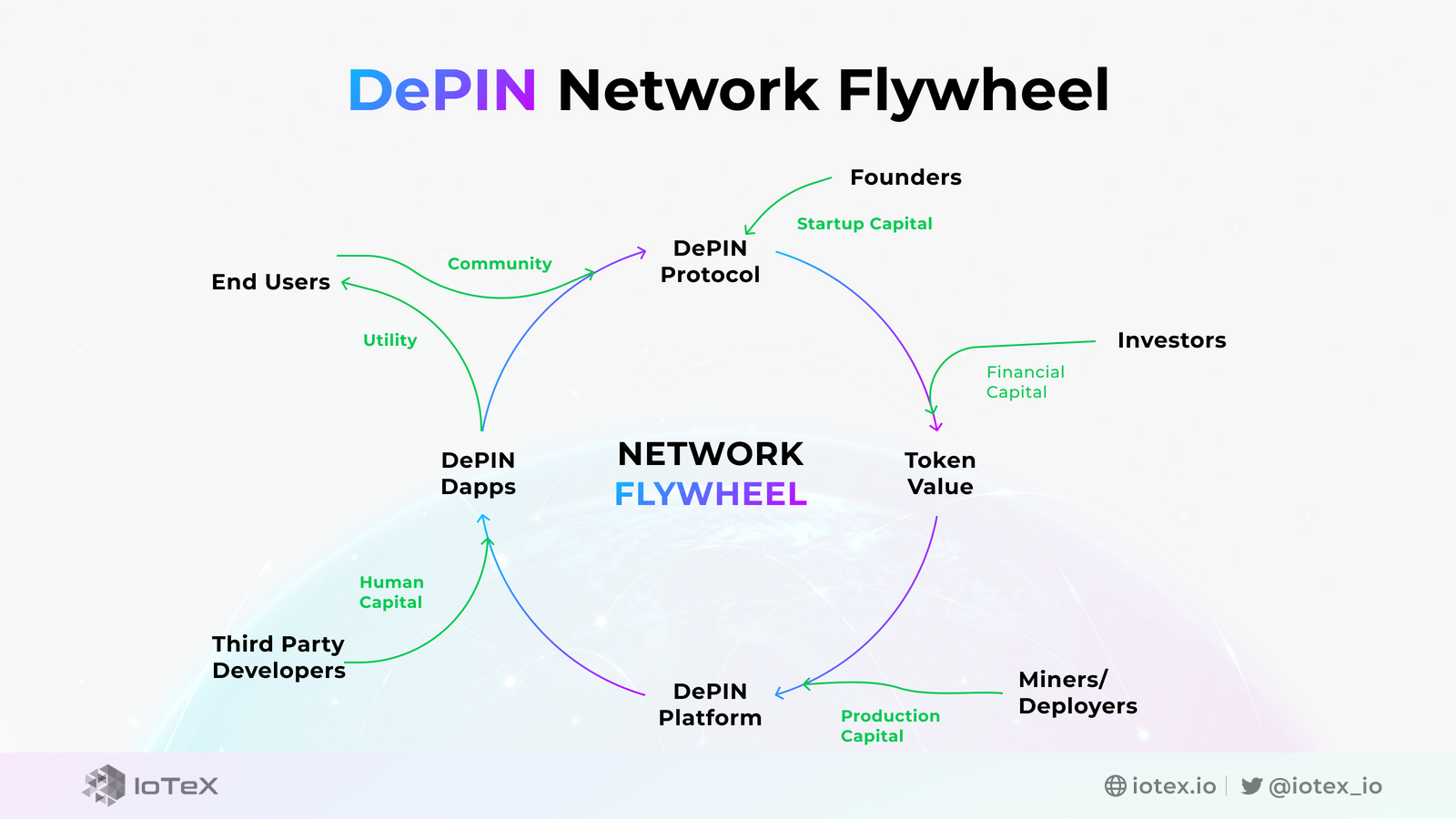
Helium used this Flywheel to great effect to motivate people around the world to build out the world's largest IoT network in just three years (400k+ hotspots online globally). The Helium Network proved out the power of this Flywheel effect and provided a blueprint for the rest of the DePIN industry, which is now utilizing it to great effect in sectors as diverse as energy, mobility, and weather!
While DePIN projects will no doubt utilize their tokens and this Flywheel effect to catalyze their network growth, IoTeX is ready and willing to help DePIN projects on other fronts as well.
IoTeX's role in the DePIN sector
In May of 2023, Messari published a follow-up piece on DePIN infrastructure, including an analysis of the various blockchains that DePIN projects are building on and also other companies serving the industry in a variety of ways.
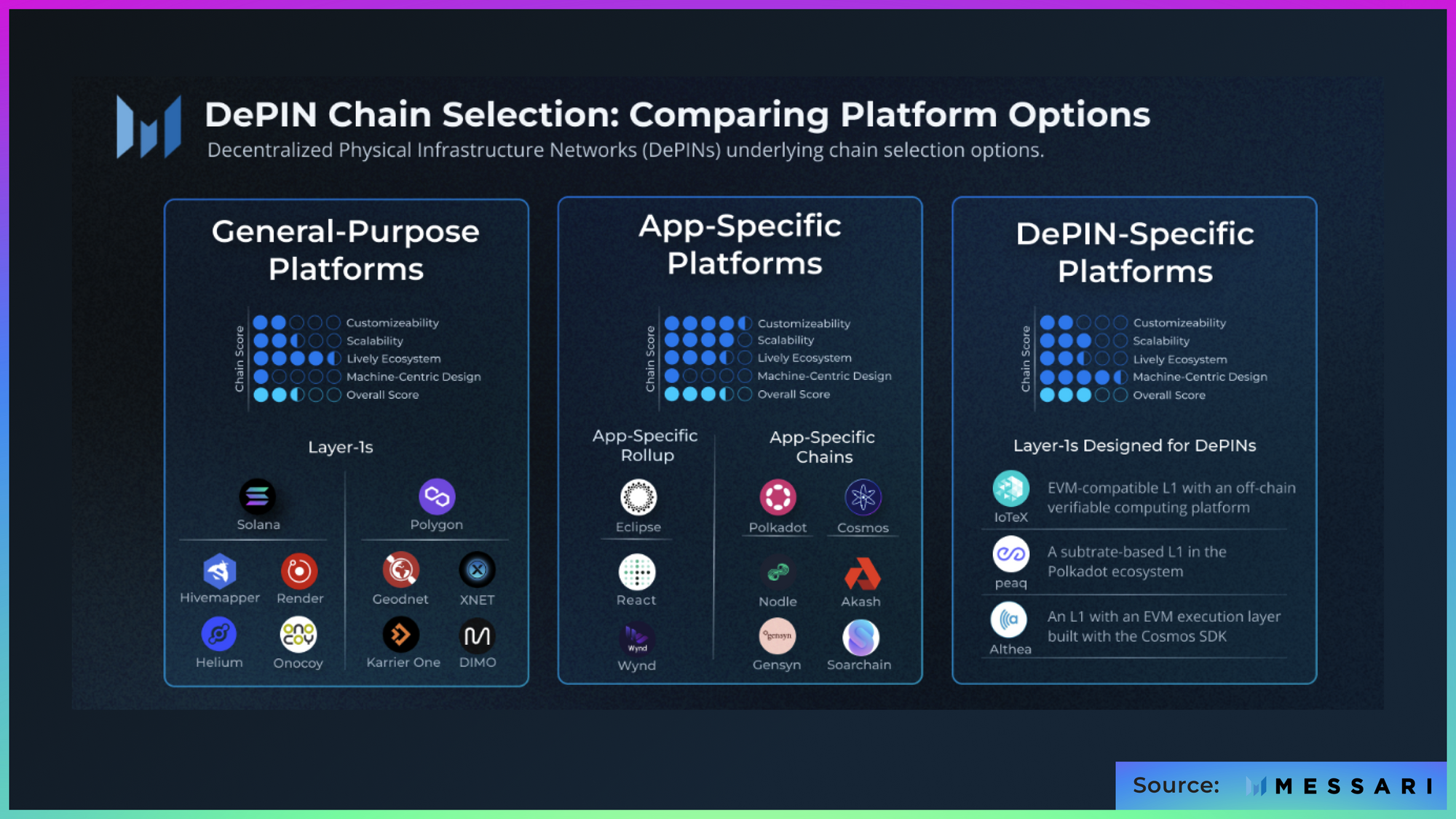
IoTeX was mentioned as an EVM-compatible Layer 1 blockchain purpose-built for machine data and DePIN startups. Our W3bstream off-chain compute platform connects data from smart devices to smart contracts. The image below describes how W3bstream sits in between the blockchain and physical devices as a real-world "oracle", similar to Chainlink. Our hardware development kits, embedded SDKs for Android, iOS, Arduino, Raspberry Pi, as well as our API and cloud backend connection options provide an easy way for developers to ingest data from the physical world into their W3bstream environment.
W3bstream supports all EVM-compatible chains and will soon expand support for non-EVM chains like Solana that are popular with DePIN developers as well.

Outside of W3bstream, IoTeX has a variety of other products and services that enable DePIN development. The picture below shows the myriad of ways in which we look to catalyze the DePIN sector across the entire tech stack.
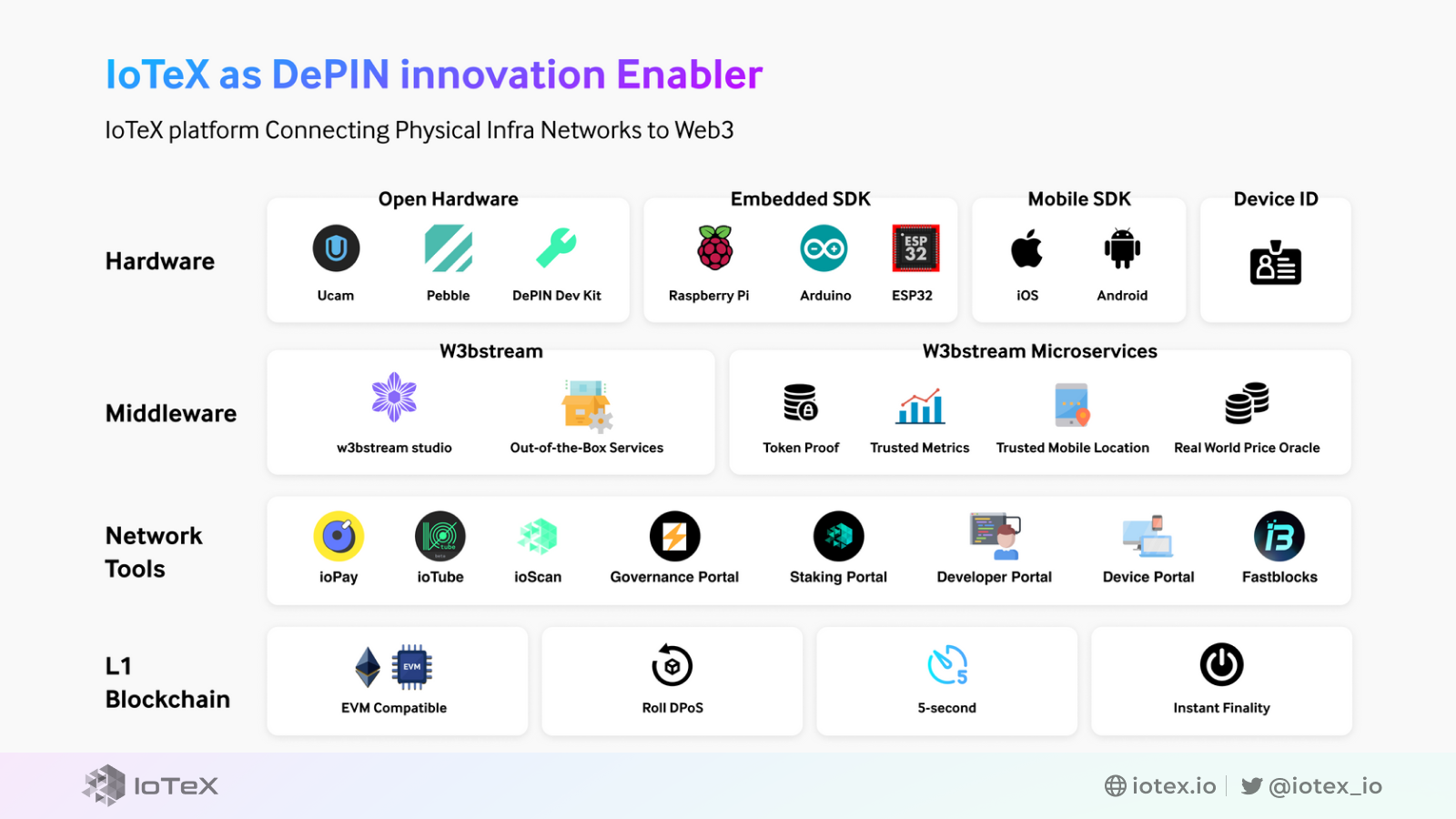
We'll dive more deeply into the other ways IoTeX is supporting companies building at the intersection of the real world and blockchains in the next section.
How IoTeX helps
IoTeX is the go-to infrastructure provider for any company looking to represent physical devices and their data (and do something with that data) on-chain! We enable DePIN innovation and assist ambitious builders by providing decentralized infrastructure, developer tools, and go-to-market support. Our expertise comprises three primary components:
🏗️ Blockchain & Off-chain Compute Infrastructure
- IoTeX W3bstream is a first-of-its-kind, chain-agnostic, decentralized protocol that connects real-world data from smart devices to smart contracts. W3bstream provides an off-chain environment for developers to crowdsource data from users' smart devices. It generates "proofs of real-world activity" that can trigger smart contracts to deliver digital assets (such as cryptocurrency, stablecoins, and NFTs) to users.
- IoTeX L1 is a secure, decentralized, and developer-friendly platform for building and scaling Web 3.0 and DePIN applications.
🛠️ Developer Tools
- ioPay is a multi-chain crypto wallet for managing IoTeX accounts and major L1s/L2s.
- ioTube is a cross-chain bridge for transferring tokens between IoTeX and major L1s/L2s.
- iotexscan is an IoTeX blockchain explorer for viewing the full transaction history and asset holdings.
- Staking Portal makes it easy to stake $IOTX tokens and vote for Delegates to join network consensus.
- Fastblocks is IoTeX's "Infura" for easily starting and managing blockchain full nodes or Delegate nodes.
- Developer Portal and Docs are for developers to access step-by-step tutorials, technical blog articles, updates, and comprehensive guides to acquire knowledge on constructing applications and contribute to and expand within the community
- DePINscan is a public good that empowers investors and DePIN enthusiasts with information crucial to making important investment decisions such as the project to invest in or which DePIN hardware to purchase. DePINscan is fueled by several sources including the W3bstream Trusted Metrics API and other third party APIs.
📦 Go-to-Market Package
- Open Hardware Manufacturing Support: Ucam and Pebble Tracker are two in-house hardware we designed and built for developers to experiment with crazy ideas of real world + blockchain that is widely recognized by the developer community. We have the expertise to design, manufacture, and ship web3 native hardware and can assist DePIN projects with their own hardware strategy.
- IoTeX Halo Grants: This is the program to accelerate the growth of the IoTeX ecosystem by providing technical guidance, financial support, marketing and community engagement, and investment opportunities to projects promoting the growth and adoption of IoTeX technology.
- IoTeX Ecosystem Fund: The IoTeX Foundation has launched a Sustainable Ecosystem Fund to support builders accelerating the IoTeX ecosystem across different categories of applications including DeFi, GameFi, NFTs, DAOs, DePIN, and Real World Web3 with the aim of connecting billions of smart devices to the blockchain networks and building the Web3 machine economy.
- Project Launch Stacks: Manage project initial liquidity on mimo.exchange, launchpads, coin listing on major dashboards, connection to top tier crypto exchanges and money makers, and many more.
- Community and Events: IoTeX has developed a robust community focused on real-world web3 applications since 2017, utilizing various social media platforms to foster engagement. We also invite DePIN projects into events (https://r3alworld.com) we host, e.g., R3alworld@ETHDenver’23 attracted 1000+ DePIN developers and investors.
Across our blockchain and off-chain compute infrastructure, developer tooling, and go-to-market package, IoTeX has helped (and will continue to help) promising DePIN projects grow and gain traction for years to come.
DePIN: let's build tomorrow's infrastructure together, today
To recap, Decentralized Physical Infrastructure Networks (DePIN) represent a paradigm shift in the deployment and maintenance of physical infrastructure. By leveraging cryptoeconomic protocols and blockchain technology, DePINs enable a more efficient, decentralized, and equitable approach to infrastructure deployment.
With the ability to scale rapidly and the potential to disrupt large traditional industries, DePIN has the potential to become a major player in the world of infrastructure. As more of these projects are developed and deployed, we can expect to see significant disruption and innovation in the way we build and maintain physical infrastructure networks.
While any revolutionary new technology brings with it unique challenges, we remain convinced of the power of this model to improve the infrastructure and quality of life of the world's population. Here at IoTeX, we're incredibly excited about the innovation and growth that are occurring here and will continue to support the DePIN space in every way possible. If you're as excited as we are about building out infrastructure in a decentralized way, head over to https://w3bstream.com/ to learn more.
For more specific inquiries, please contact our team members below:
- If you're a developer, contact our Dev Rel lead Simone at [email protected]
- If you're a project founder, contact our BD lead Larry at [email protected]
- If you're an investor, contact our Head of Investment Jing at [email protected]